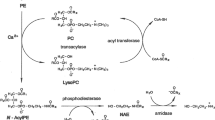Abstract
The principal monohydroxyeicosatetraenoic acids (HETEs), 5-, 12-, and 15-HETE, which can be produced by rat basophilic leukemia (RBL-1) cells, are also esterified by these cells. Exogenously added 5-, 12-, and 15-HETE were rapidly incorporated as esters in RBL cells, reaching plateau levels within 25 min. In incubations in culture medium with protein added, all three HETEs were essentially completely metabolized within 24 h. 5-HETE was esterified more rapidly and to a greater extent than 12-HETE or 15-HETE when these were incubated together with RBL cells, indicating some degree of selectivity in the esterification pathways. When arachidonic acid (AA) was incubated in increasing concentrations with constant concentrations of 15-HETE and RBL cells, the free 15-HETE concentration increased and esterified 15-HETE concentration decreased markedly at AA: 15-HETE molar ratios above 9. 15-HETE esterification in RBL cells was also markedly inhibited by the polyunsaturated fatty acids, eicosatetraynoic and eicosapentanoic acids, but not by oleic or linoleic acids. In separate experiments with unlabeled and radiolabeled substrates, the extent of incorporation of esterified HETE in RBL cells decreased at higher concentrations of 15-HETE and AA, which showed that the pathway was saturable. The shapes of the curves for these fatty acid inhibitors suggest a concentration-dependent two compartment pathway of esterification. These data indicate that the HETEs and other 20 carbon fatty acid substrates probably compete for activity of a specific arachidonyl-CoA synthetase, which is the first and rate-limiting step for esterification of arachidonic acid by many human cells. Esterified 15-HETE was found to be predominantly in the phosphatidylethanolamine fraction of RBL cell lipids.
Similar content being viewed by others
References
Spector, A. A., J. A. Gordon, andS. A. Moore. 1988. Hydroxyeicosatetraenoic acids (HETEs).Prog. Lipid Res. 27:271–323.
Baer, A. N., P. B. Costello, andF. A. Green. 1990. Characterization of the chirality of the monohydroxyeicosatetraenoic acids produced by rat basophilic leukemia cells.Biochem. Biophys. Res. Commun. 169:332–338.
Kates, M.. 1975. Techniques of lipidology.In Laboratory Techniques in Biochemistry and Molecular Biology, Vol. 3, Part II. T. S. Work and E. Work, Editors. Elsevier, North-Holland, Amsterdam. 558.
Baer, A. N., P. B. Costello, andF. A. Green. 1990. Free and esterified 13(S,R)-hydroxyoctadecadienoic acids: Principal oxygenase products in psoriatic skin scales.J. Lipid Res. 31:125–130.
Hansson, G., C. Malmsten, andO. Radmark. 1983. The leukotrienes and other lipoxygenase products.In Prostaglandins and Related Substances. C. Pace-Asciak and E. Granstrom, editors. Elsevier, Amsterdam. 127–169.
Wilson, D. B., S. M. Prescott, andP. W. Majerus. 1982. Discovery of an arachidonoyl coenzyme A synthetase in human platelets.J. Biol. Chem. 257:3510–3515.
Neufeld, E. J., H. Sprecher, R. W. Evans, andP. W. Majerus. 1984. Fatty acid structural requirements for activity of arachidonoyl-CoA synthetase.J. Lipid Res 25:288–293.
Laposata, M., E. L. Reich, andP. W. Majerus. 1985. Arachidonoyl-CoA synthetase. Separation from nonspecific acyl-CoA synthetase and distribution in various cells and tissues.J. Biol. Chem. 260:11016–11020.
McKinney, M. 1987. Blockade of receptor-mediated cyclic GMP formation by hydroxyeicosatetraenoic acid.J. Neurochem. 49:331–341.
Pawlowsli, N. A., W. A. Scott, M. Andreach, andZ. A. Cohn. 1982. Uptake and metabolism of monohydroxyeicosatetraenoic acids by macrophages.J. Exp. Med. 155:1653–1664.
Richards, C. F., A. R. Johnson, andW. B. Campbell. 1986. Specific incorporation of 5-hydroxy-6,8,1 1,14-eicosatetraenoic acid into phosphatidylcholine in human endothelial cells.Biochim. Biophys. Acta 875:569–581.
Shen, X.-Y., P. H. Figaro, T. L. Kaduce, andA. A. Spector. 1988. Conversion of 15-hydroxyeicosatetraenoic acid to 11-hydroxyhexadecatrienoic acid by endothelial cells.Biochemistry 27:996–1004.
Stenson, W. F., M. W. Nickells, andJ. P. Atkinson. 1983. Esterification of monohydroxy fatty acids into the lipids of a macrophage cell line.Prostaglandins 26:253–264.
Bonser, R. W., M. I. Siegel, S. M. Chung, R. T. McConnell, andP. Cuatrecasas. 1981. Esterification of an endogenously synthesized lipoxygenase product into granulocyte cellular lipids.Biochemistry 20:5297–5301.
Gordon, J. A., andA. A. Spector. 1987. Effects of 12-HETE on renal tubular epithelial cells.Am. J. Physiol. 253(Cell Physiol. 22):C277–C285.
Sha'afi, R. I., P. H. Naccache, T. Alobaidi, T. F. P. Molski, andJ. Volpi. 1981. Effect of arachidonic acid and the chemotactic factor f-Met-Leu-Phe on cation transport in rabbit neutrophils.J. Cell. Physiol. 106:215–223.
Stenson, W. F., andC. W. Parker. 1979. 12-L-hydroxy-5,8,10,14-eicosatetraenoic acid, a chemotactic fatty acid, is incorporated into neutrophil phospholipids and triglyceride.Prostaglandins 18:285–292.
Stenson, W. F., andC. W. Parker. 1979. Metabolism of arachidonic acid in ionophores-timulated neutrophils. Esterification of a hydroxylated metabolite into phospholipids.J. Clin. Invest. 64:1457–1465.
Brezinski, M. E., andC. N. Serhan. 1990. Selective incorporation of (15S)-hydroxyeicosatetraenoic acid in phosphatdylinositol of human neutrophils: Agonist-induced deacylation and transformation of stored hydroxyeicosanoids.Proc. Natl. Acad. Sci. U.S.A. 87:6248–6252.
Wey, H. E., J. A. Jakubowski, andD. Deykin. 1986. Incorporation and redistribution of arachidonic acid in diacyl and ether phospholipids of bovine aortic endothelial cells.Biochim. Biophys. Acta 878:380–386.
Spector, A. A., S. N. Mathur, T. L. Kaduce, andB. T. Hyman. 1980. Lipid nutrition and metabolism of cultured mammalian cells.Prog. Lipid Res. 19:155–186.
Rosenthal, M. D. 1987. Fatty acid metabolism of isolated mammalian cells.Prog. Lipid Res. 26:87–124.
Author information
Authors and Affiliations
Additional information
Supported by the Veterans Administration and the Arthritis Foundation of Western New York.
Rights and permissions
About this article
Cite this article
Costello, P.B., Baer, A.N. & Green, F.A. Saturability of esterification pathways of major monohydroxyeicosatetraenoic acids in rat basophilic leukemia cells. Inflammation 15, 269–279 (1991). https://doi.org/10.1007/BF00917312
Issue Date:
DOI: https://doi.org/10.1007/BF00917312




